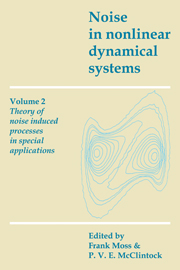Book contents
- Frontmatter
- Contents
- List of contributors
- Preface
- Introduction to Volume 2
- 1 Stochastic processes in quantum mechanical settings
- 2 Self-diffusion in non-Markovian condensed-matter systems
- 3 Escape from the underdamped potential well
- 4 Effect of noise on discrete dynamical systems with multiple attractors
- 5 Discrete dynamics perturbed by weak noise
- 6 Bifurcation behavior under modulated control parameters
- 7 Period doubling bifurcations: what good are they?
- 8 Noise-induced transitions
- 9 Mechanisms for noise-induced transitions in chemical systems
- 10 State selection dynamics in symmetry-breaking transitions
- 11 Noise in a ring-laser gyroscope
- 12 Control of noise by noise and applications to optical systems
- 13 Transition probabilities and spectral density of fluctuations of noise driven bistable systems
- Index
11 - Noise in a ring-laser gyroscope
Published online by Cambridge University Press: 05 January 2012
- Frontmatter
- Contents
- List of contributors
- Preface
- Introduction to Volume 2
- 1 Stochastic processes in quantum mechanical settings
- 2 Self-diffusion in non-Markovian condensed-matter systems
- 3 Escape from the underdamped potential well
- 4 Effect of noise on discrete dynamical systems with multiple attractors
- 5 Discrete dynamics perturbed by weak noise
- 6 Bifurcation behavior under modulated control parameters
- 7 Period doubling bifurcations: what good are they?
- 8 Noise-induced transitions
- 9 Mechanisms for noise-induced transitions in chemical systems
- 10 State selection dynamics in symmetry-breaking transitions
- 11 Noise in a ring-laser gyroscope
- 12 Control of noise by noise and applications to optical systems
- 13 Transition probabilities and spectral density of fluctuations of noise driven bistable systems
- Index
Summary
Introduction and overview
In the year 1851 Foucault demonstrated that the slow rotation of the plane of vibration of a pendulum could be used as evidence of the earth's own rotation. The first optical experiment to detect the earth's rotation was performed by Michelson and Gale (Michelson, 1925a, b) using an unusually large size for an interferometer: 0.4 miles × 0.2 miles. Nowadays high precision measurements of the earth's rotation are performed by using radio telescopes in very long baseline interferometry (Johnson et al., 1979). Moreover, a recent proposal (Small and Chow, 1982) take advantage of the ultra high sensitivity of a ring-laser gyroscope (Aronowitz, 1965, 1971; Chow et al., 1985; Menegozzi and Lamb, 1973; Privalov and Fridrikhov, 1969) of 10 m diameter to monitor changes in earth rate or universal time. The underlying principle of such a device is the optical analog of the Foucault pendulum, the so-called Sagnac effect (Post, 1967; Sagnac, 1913a, b). The frequencies of two counterpropagating waves in a ring interferometer are slightly different when the interferometer is rotated about an axis perpendicular to its plane. Since this frequency difference is proportional to the rotation rate it provides a direct measure of the rotation of the system.
Ring-laser gyroscopes of this size would also allow tests (Schleich and Scully, 1984; Scully, Zubairy and Haugan, 1981) of metric gravitation theories (Misner, Thorne and Wheeler, 1973).
Information
- Type
- Chapter
- Information
- Noise in Nonlinear Dynamical Systems , pp. 271 - 292Publisher: Cambridge University PressPrint publication year: 1989
Accessibility standard: Unknown
Why this information is here
This section outlines the accessibility features of this content - including support for screen readers, full keyboard navigation and high-contrast display options. This may not be relevant for you.Accessibility Information
- 2
- Cited by
